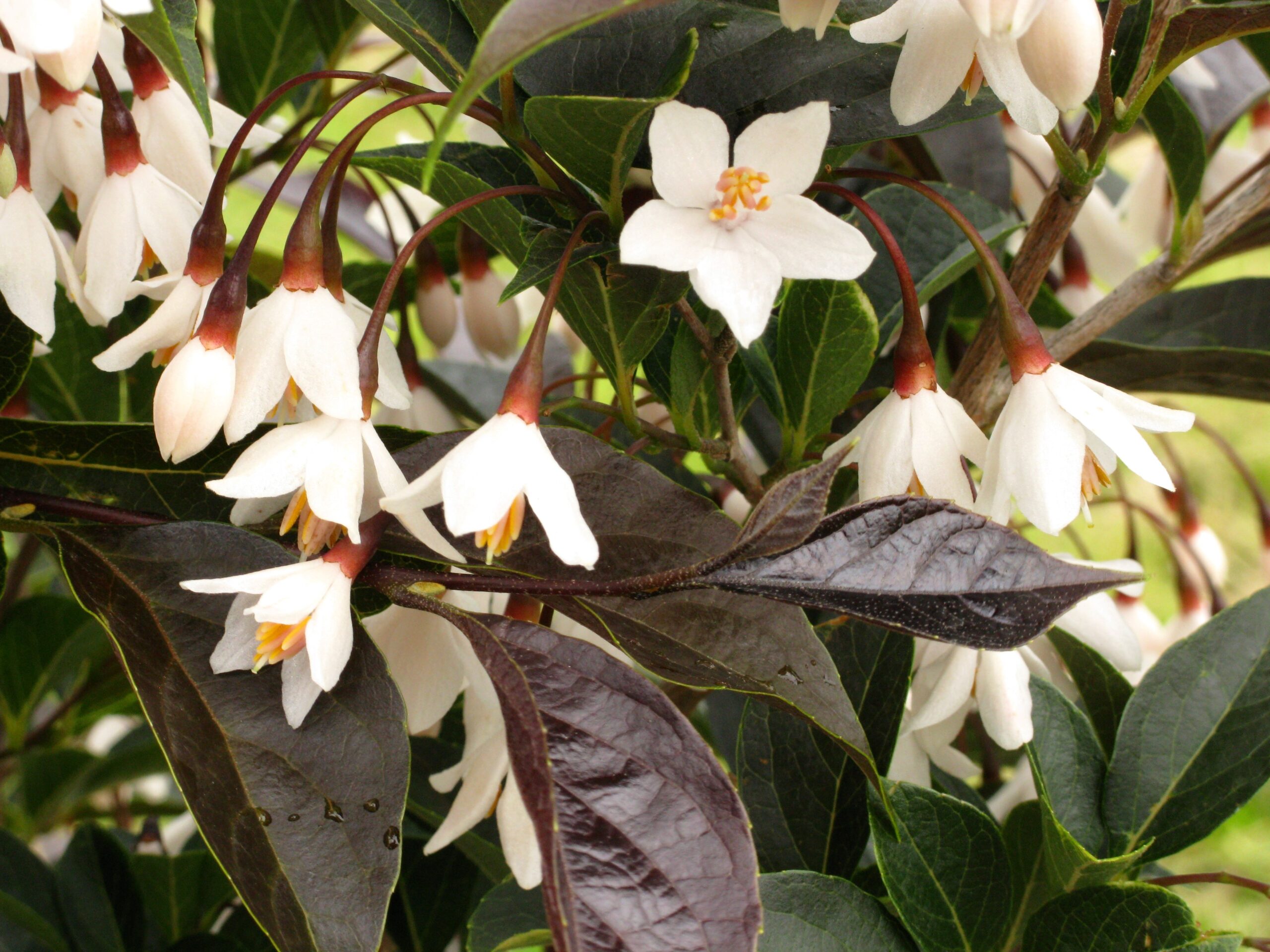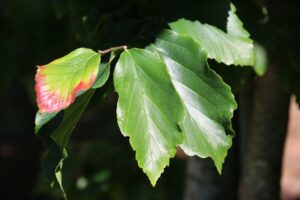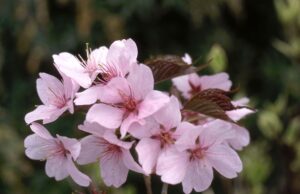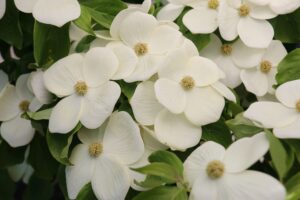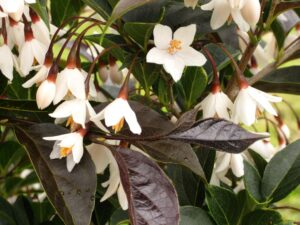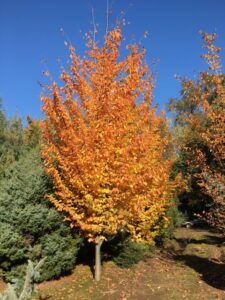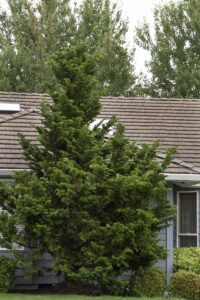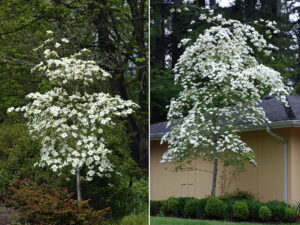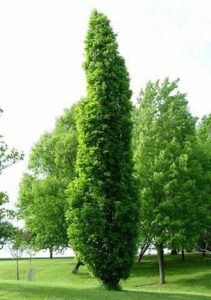With today’s smaller lot sizes and smaller front and back yards, trees might be the last thing that you would think of planting. But in celebration of Arbor Day this year, we asked an arborist Kevin Carr at Bartlett Tree Experts and tree expert Nancy Buley at tree grower J. Frank Schmidt & Son Co. for recommendations on ten great trees that would be suitable for a small lot.
From J. Frank Schmidt & Son Co.
Buley said these recommendations are well-suited to the Pacific Northwest, have beautiful flowers, healthy summer foliage and good fall color, are easy to care for and have excellent disease resistance. They’re listed in order of when they bloom.
Ruby Vase® Parrotia (Parrotia persica ‘Inge’s Ruby Vase’)
Named for its upright, vase-shaped form and colorful new growth that emerges ruby red in spring, this compact cultivar of Persian Parrotia puts on a show throughout the year. Red tipped new growth matures to dark green, heat-tolerant summer foliage that turns bright orange red in autumn. Look closely to see the exquisite flowers that open in late winter to reveal bright red stamens. Though subtle, the tiny flowers complement the beauty of its exfoliating grey and tan bark. Upright branches with open angles form a strong, storm-resistant canopy that casts cool summer shade. Urban-tolerant and adaptable, it becomes slightly wider at maturity than the better-known cultivar ‘Vanessa’ as it reaches a mature height and spread of about 28’ x 16’. Discovered at a nursery near Vancouver, British Columbia, it has proven to be a top performer in the Pacific Northwest since its introduction in 2001.
Pink Flair® Cherry (Prunus sargentii ‘JFS-KW58’)
Big clusters of bright pink, single flowers burst from the upright branches of this compact, narrowly vase-shaped tree that’s a good fit for today’s landscapes. Dark green, healthy foliage withstands the heat of summer and periods of drought. Orange-red fall color is consistently bright and long lasting. Upright symmetry lends winter appeal, along with distinctive, polished brown bark that is accented by tannish-cream lenticels. A standout for disease resistance, it is also significantly hardier than other pink-flowering cherries. Selected from seed collected from Hokkaido, Japan, it has proven hardy through Zone 3b. Offering the best cold hardiness and resistance to cherry foliage diseases, it is a popular choice for the Pacific Northwest – on both sides of the Cascades. High desert gardeners will appreciate that blooms avoid frost damage by appearing a week or two later than is typical of the species.
Sparkling Sprite® Crabapple (Malus ‘JFS-KW207’ PP 27954)
Pink buds open to fragrant, pink-tinged white flowers that smother its densely branched, rounded head. Genetically destined to be a topiary tree, Sparkling Sprite® Crabapple attains a perfectly symmetrical, rounded head with little to no pruning. Perfectly suited for patio, terrace or container culture, the summer foliage of this petite top-grafted tree is especially clean, bright green and disease resistant. Abuzz with pollinators when its pink buds open to pink-tinged white flowers, the fragrant flowers put on a remarkable show. The four-season show goes on well into winter, when an abundant crop of tiny persistent fruits turns from golden yellow to orange and attracts birds to the garden.
Starlight® Dogwood (Cornus kousa x nuttallii ‘KN-43’ PP 16293)
Dark green foliage sets the stage for large, long-lasting creamy white flowers that appear in late spring. Similar in appearance to our native Pacific dogwood, its mildew and anthracnose-resistant foliage blankets the branches of this upright oval tree throughout the summer months. A smattering of orange fruits of 3/4-inch diameter appears among the leaves in late summer and lasts into fall, when foliage turns to bright red orange. This adaptable hybrid of Pacific and Chinese dogwoods developed at Rutgers University grows to a height and spread of about 30’ by 20’.
Evening Light Snowbell (Styrax japonicus ‘Evening Light’ PP 24168)
Unique among snowbells, the leaves of this unique cultivar emerge green and quickly mature to purple black. They provide a dramatically dark backdrop for a profusion of pearl-like buds. These burst open to reveal fragrant, white, bell-shaped flowers, delighting people and pollinators in early summer when few trees offer a floral display. With adequate soil moisture, some reblooming will occur. Heat-resistant foliage maintains its dark hue throughout the hot summer months. Upright oval in form, it reaches a height and spread of approximately 15’ by 10’.
From Bartlett Tree Experts
Parrotia persica ‘Vanessa’ (Persian ironwood)
A small, upright tree with attractive, flaking bark and small red flowers on bare stems in late winter and early spring. The young foliage is red and bronze turning green for summer then producing spectacular fall color with shades of red, orange and purple.
City Sprite® Zelkova (Zelkova serrata ‘JFS-KW1’ PP20996)
Compact, dense, and semi-dwarf, this is a suitable smaller tree for smaller urban spaces. Summer foliage appears brighter green than typical Zelkova. Short internodes, fine textured foliage.
Slender Hinoki false cypress (Chamaecyparis obtusa ‘Gracilis’)
An open-branched, pyramidal form with gracefully arching branchlets. Tiny, deep green needles with new reddish growth has a soft, ferny appearance and develop bronze coloring in winter. An excellent small, slender evergreen tree for screening, hedges, and background plantings.
‘Eddies White Wonder’ dogwood (Cornus nuttallii x florida)
A slow-growing Dogwood, forming a small garden tree or medium sized deciduous shrub. Large white bracts, red fall color. It is suited to sunny and partially shaded positions with well-drained soil.
Kindred Spirit® hybrid oak (Quercus × warei ‘Nadler’)
Kindred Spirit® oak is a hybrid of a Swamp Oak (Q. bicolor) and the Columnar English Oak (Q. robur ‘Fastigiata’). It has a columnar growth habit, and it was bread to be powdery mildew resistant. Even though it is a hybrid it still produces acorns that provide a food source for small mammals.

